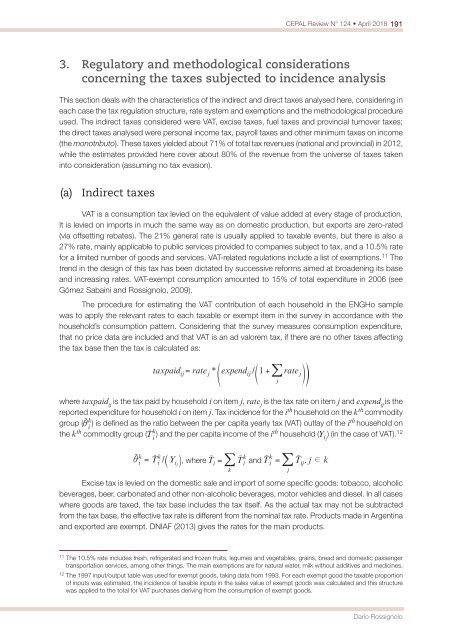CEPAL Review no. 124
April 2018
April 2018
You also want an ePaper? Increase the reach of your titles
YUMPU automatically turns print PDFs into web optimized ePapers that Google loves.
<strong>CEPAL</strong> <strong>Review</strong> N° <strong>124</strong> • April 2018 191<br />
3. Regulatory and methodological considerations<br />
concerning the taxes subjected to incidence analysis<br />
This section deals with the characteristics of the indirect and direct taxes analysed here, considering in<br />
each case the tax regulation structure, rate system and exemptions and the methodological procedure<br />
used. The indirect taxes considered were VAT, excise taxes, fuel taxes and provincial tur<strong>no</strong>ver taxes;<br />
the direct taxes analysed were personal income tax, payroll taxes and other minimum taxes on income<br />
(the mo<strong>no</strong>tributo). These taxes yielded about 71% of total tax revenues (national and provincial) in 2012,<br />
while the estimates provided here cover about 80% of the revenue from the universe of taxes taken<br />
into consideration (assuming <strong>no</strong> tax evasion).<br />
(a) Indirect taxes<br />
VAT is a consumption tax levied on the equivalent of value added at every stage of production.<br />
It is levied on imports in much the same way as on domestic production, but exports are zero-rated<br />
(via offsetting rebates). The 21% general rate is usually applied to taxable events, but there is also a<br />
27% rate, mainly applicable to public services provided to companies subject to tax, and a 10.5% rate<br />
for a limited number of goods and services. VAT-related regulations include a list of exemptions. 11 The<br />
trend in the design of this tax has been dictated by successive reforms aimed at broadening its base<br />
and increasing rates. VAT-exempt consumption amounted to 15% of total expenditure in 2006 (see<br />
Gómez Sabaini and Rossig<strong>no</strong>lo, 2009).<br />
The procedure for estimating the VAT contribution of each household in the ENGHo sample<br />
was to apply the relevant rates to each taxable or exempt item in the survey in accordance with the<br />
household’s consumption pattern. Considering that the survey measures consumption expenditure,<br />
that <strong>no</strong> price data are included and that VAT is an ad valorem tax, if there are <strong>no</strong> other taxes affecting<br />
the tax base then the tax is calculated as:<br />
where taxpaid ij<br />
is the tax paid by household i on item j, rate j<br />
is the tax rate on item j and expend ij<br />
is the<br />
reported expenditure for household i on item j. Tax incidence for the i th household on the k th commodity<br />
group ( ) is defined as the ratio between the per capita yearly tax (VAT) outlay of the i th household on<br />
the k th commodity group ( ) and the per capita income of the i th household ( ) (in the case of VAT). 12<br />
, where and<br />
Excise tax is levied on the domestic sale and import of some specific goods: tobacco, alcoholic<br />
beverages, beer, carbonated and other <strong>no</strong>n-alcoholic beverages, motor vehicles and diesel. In all cases<br />
where goods are taxed, the tax base includes the tax itself. As the actual tax may <strong>no</strong>t be subtracted<br />
from the tax base, the effective tax rate is different from the <strong>no</strong>minal tax rate. Products made in Argentina<br />
and exported are exempt. DNIAF (2013) gives the rates for the main products.<br />
11<br />
The 10.5% rate includes fresh, refrigerated and frozen fruits, legumes and vegetables, grains, bread and domestic passenger<br />
transportation services, among other things. The main exemptions are for natural water, milk without additives and medicines.<br />
12<br />
The 1997 input/output table was used for exempt goods, taking data from 1993. For each exempt good the taxable proportion<br />
of inputs was estimated, the incidence of taxable inputs in the sales value of exempt goods was calculated and this structure<br />
was applied to the total for VAT purchases deriving from the consumption of exempt goods.<br />
Darío Rossig<strong>no</strong>lo


















